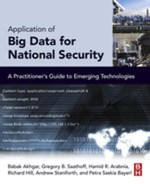Barlow M. Real-time Big Data Analytics: Emerging Architecture. O’Reilly; 2013.
Bdaily. Big Data: Realising Opportunities and Assessing Risk, Bdaily, Business News. Bdaily Ltd; 2013.
Biem A, Feng H, Riabov A, Turaga D. Real-time analysis and management of big time-series data. IBM Journal of Research and Development. 2013;57 8:1–8:12.
Cisco. Cisco Visual Networking Index: Forecast and Methodology, 2013–2018. 2014 (Online). Available from: http://www.cisco.com/c/en/us/solutions/collateral/service-provider/ip-ngn-ip-next-generation-network/white_paper_c11-481360.html.
Courtney M. Big Data analytics: putting the puzzle together. Engineering and Technology Magazine. 2012;7:56–57.
Courtney M. The larging-up of Big Data. IET Engineering and Technology. 2012;7:72–75.
Dong X, Srivatsava D. Big Data integration. In: 29th International Conference on Data Engineering (ICDE). Brisbane: IEEE; 2013:1245–1248.
Eaton C, Deroos D, Deutsch T, Lapis G, Zikopoulos P. Understanding Big Data. McGraw Hill; 2012.
Gammerman A, Cole J, Gollins T, Lewis H, Mandoli G, Bennett N, Lynch M, Velasco E, Tsai. Big Data for security and resilience. In: Cole J, ed. Pro. of Big Data for Security and Resilience: Challenges and Opportunities for the Next Generation of Policy-makers. RUSI and STFC; 2014:1–85.
Gartner. Gartner Says Solving ‘Big Data’ Challenge Involves More than Just Managing Volumes of Data. Gartner; 2011 (Online). Available from: http://www.gartner.com/newsroom/id/1731916.
Google, Google BigQuery, What Is BigQuery? (Online). Available from: https://cloud.google.com/bigquery/what-is-bigquery.
Gualtieri M. The Forrester Wave: Big Data Predictive Analytics Solutions, Q1 2013. Forrester Research; 2013 Available from: http://www.sas.com/resources/asset/Forrester85601-LR8KBD.pdf.
Harriott J. InfoSphere BigInsights, Bringing the Power of Hadoop to the Enterprise. 2013 (Online). Available from: http://www-01.ibm.com/software/data/infosphere/biginsights/.
Hirzel M, Andrade H, Gedik B, Jacques-Silva G, Khandekar R, Kumar V, Mendell M, Nasgaard H, Schneider S, Soule R, Wu R. IBM streams processing language: analyzing Big Data in motion. IBM Journal of Research and Development. 2013;57 7:1–7:11.
Hofstee H, Chen C, Gebara F, Hall K, Herring J, Jamsek D, Li J, Li Y, Shi J, Wong P. Understanding system design for Big Data workloads. IBM Journal of Research and Development. 2013;57 3:1–3:10.
HP. HP Unleashes the Power of Big Data, Expanded Portfolio Accelerates Adoption, Monetization of Information (Online). Las Vegas: HP; 2013 Available from: http://www8.hp.com/us/en/hp-news/press-release.html?id=1416090#.Ud7rcPnI3Qg.
Ji C, Li Y, Qiu W, Awada U, Li K. Big Data processing in cloud computing environments. In: 12th International Symposium on Pervasive Systems, Algorithms and Networks (ISPAN). San Marcos: IEEE; 2012:17–23.
Kumar A, Lee H, Singh R. Efficient and secure cloud storage for handling big data. In: 6th International Conference on New Trends in Information Science and Service Science and Data Mining (ISSDM). Taipei: IEEE; 2012:162–166.
Laney D. 3D Data Management: Controlling Data Volume, Velocity, and Variety. META Group; 2001 Available from: http://blogs.gartner.com/doug-laney/files/2012/01/ad949-3D-Data-Management-Controlling-Data-Volume-Velocity-and-Variety.pdf.
Liu H. Big Data drives cloud adoption in Enterprise. Internet Computing. 2013;17:68–71.
Madden S. From databases to Big Data. IEEE Internet Computing. 2012;16:4–6.
Malik P. Governing big data: Principles and practices. IBM Journal of Research and Develpoment. 2013;57 1:1–1:13.
Mitchell I, Loke M, Wilson M, Fuller A. The White Book Big Data. Fujitsu Services Ltd; 2012.
Murdoch J. Critics of Big Data have overlooked the speed factor. The Guardian. Monday May 20, 2013 (Online). Available from: http://www.theguardian.com/news/datablog/2013/may/20/big-data-critics-overlooked-speed-not-size.
Murtagh R. Seize the Data: 5 Ways to Leverage Big Data for Social Media & Search. New York: Incisive Interactive Marketing LLC; 2013.
O’Leary D. Artificial Intelligence and Big Data. IEEE Intelligent Systems. 2013;28:96–99.
Pimentel F. Big Data + Mainframe. Smarter Computing. IBM; 2014.
Schroeck M, Shockley R, Smart J, Romero-Morales D, Tufano P. Analytics: The Real-world Use of Big Data (Online). IBM Institute for Business Value; 2012 Available from: http://www-935.ibm.com/services/us/gbs/thoughtleadership/ibv-big-data-at-work.html.
Talia D. Clouds for scalable Big Data analytics. Computer. 2013;46:98–101.
Thomas R. IBM Big Data Success Stories. IBM; 2012 pp. 1–70.
Wigan M, Clarke R. Big Data’s big unintended consequences. IEEE Computer. 2012;46:46–53.
